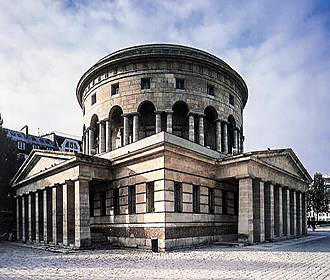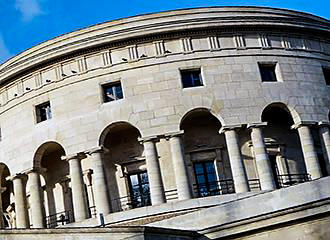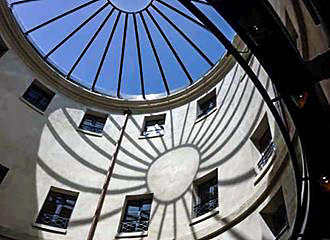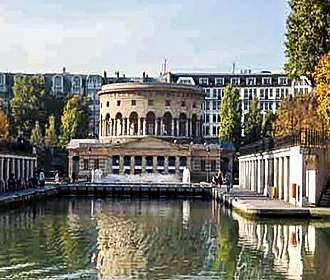Paris La Rotonde de la Villette History
Constructed in a record time of two years and completed in 1788 by the architect Claude Nicolas Ledoux, the Paris La Rotonde de la Villette was a gateway to Paris for offices to collect tax on the goods entering Paris via the road and canals in this area.
Beginnings of the Paris La Rotonde de la Villette
There were buildings that needed to be constructed as barriers all part of the Wall of the Farmers General, so they could take tolls and inspect goods from traders entering into Paris, and there were over fifty of these buildings constructed around the city.
The majority of these original toll barriers were destroyed many years ago, although there are a few that remain including the Barriere de Chartres at the Rotonde of Parc Monceau and the Barriere Saint-Martin at the Paris Rotonde de la Villette.
These were designed by the architect Claude Nicolas Ledoux and by the Canal Saint-Martin there were originally two buildings opposite each other on the road that is now called the Rue de Flandre and another two opposite each other at Pantin that made up these barriers.
There was a fifth building constructed in this area, which was the Paris Rotonde de la Villette, which is located on the Place de la Bataille de Stalingrad overlooking the canal and the Bassin de la Villette, and this is the only one of these particular toll buildings that have remained in the area.
When it was constructed, they did so in an almost neo-classical style that was meant to represent traditional designs with representations of modern progress within the city, and this was the most impressive Rotonde, that at the time was to be utilised for offices of the controllers and the guards.
On the ground level on each of the facades you can see symmetrical pillars topped by a triangular pediment, whereas the upper level has a true rotunda that is comprised of 20 pairs of pillars, and today this is now classified as an historical monument in Paris.
Next stages of the Paris La Rotonde de la Villette History
Now over its history it managed to avoid being destroyed during the French Revolution, and then the grant toll tax was abolished in 1791, which meant that the building remained empty for some time.
But in 1804 the Paris La Rotonde de la Villette was taken over by the city of Paris, who then ended up utilising the building as barracks for the Municipal Guard, which was from 1830 through to 1860.
Yet this impressive building managed to avoid destruction again during the improvements made by Baron Haussmann in the 1860s, which is when many old buildings were torn down to make way for wide avenues and elaborate new buildings, although in 1865 this building became a salt storehouse.
Then in 1871 it yet again avoided destruction through the problems caused during the Paris Commune, and yet again, the Paris La Rotonde de la Villette still stayed in place, even with the construction of the new metro line 2 at the start of the 1900s.
Fortunately, this incredible part of the history of Paris was classified as an historical monument in 1904, but over the course of time major renovations would be required, and these have been conducted by architects such as Pierre Prunet, Gabor Mester de Paradj and Bruno Decaris.
More recently the chief architect for historical Paris monuments in France, Jean-Francois Lagneau, carried out the extensive renovations of the original building, which was completed by the architect Andrew Holmes.
The Paris La Rotonde de la Villette Today
Even though the facade is as it was constructed and the rotunda with its natural sky light can still be appreciated, especially from the side of the Canal Saint-Martin by the Bassin de la Villette, much of the interior is now a very modern design.
Today the Paris La Rotonde de la Villette with its newly designed venue called the Grand Masrche Satalingrad, it is a great place to stop for a meal, quick bite to eat, or a relaxing drink by the canal, plus it also hosts music nights, clubbing and concerts, and is a hive of activity every day of the week.
And with its impressive location, along with different areas and themes to eat or drink, enjoy a DJ night until the early hours, or even discover a couple of unusual boutiques and an art gallery, this makes it an ideal place in Paris for spending time with friends or family, especially if you are visiting some of the other Paris tourist attractions in this area.



